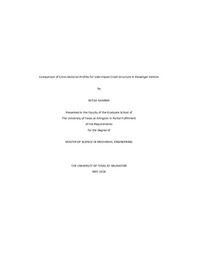
ATTENTION: The works hosted here are being migrated to a new repository that will consolidate resources, improve discoverability, and better show UTA's research impact on the global community. We will update authors as the migration progresses. Please see MavMatrix for more information.
Show simple item record
| dc.contributor.advisor | Beyle, Andrey | |
| dc.creator | Sharma, Nitish | |
| dc.date.accessioned | 2018-06-05T18:46:10Z | |
| dc.date.available | 2018-06-05T18:46:10Z | |
| dc.date.created | 2018-05 | |
| dc.date.issued | 2018-05-16 | |
| dc.date.submitted | May 2018 | |
| dc.identifier.uri | | |
| dc.identifier.uri | http://hdl.handle.net/10106/27467 | |
| dc.description.abstract | Car’s safety is most important structural criteria while designing an automotive chassis. To protect the occupants from a direct impact, the passenger cabin and the structure of the vehicle should have an appropriate stiffness so that the it absorbs any kind of impact and keeps the passenger safe. Design standards are set by various vehicle safety association around the world based on different crash situations i.e. front crash, side impact, roll over etc. Among these standards, side impact crash account for over all 40% crashes all around the world and is one of the most fatal crash scenarios. This research focuses on comparative study based on varying cross-sectional profiles for side impact crash structures such as B-Pillar and Anti Intrusion Beam. A detailed finite element study was performed to analyze static and dynamic behavior of different cross section profiles in side impact crash situation.
With the advent of technology, materials have advanced many folds; one such technical revelation has been Fiber-reinforced Composite Materials. Composite materials have two major advantages, among many others: improved strength and stiffness, especially compared to other materials on a unit weight basis and low density with ease of manufacturing. The study deals with redesigning and replacing existent side impact crash structures with carbon fiber (Cytec Thornell T652/35)
The objective of this study is to predict the behavior of different profiles specifically with composite material. The analogy to a side impact crash was derived from 3-point bend test and drop test to study the static and dynamic response of the geometry and the material. The finite element simulation was carried out in ANSYS 17.2 specifically using ACP, Static Structural and Explicit Dynamic Modules. The geometries and the material were then compared for key structural parameters such as bending stiffness, effective stresses, factor of safety and overall kinetic energy absorption. At the end of the research we were able to compare and select the profiles which will be able to absorb high side impact crash energy | |
| dc.format.mimetype | application/pdf | |
| dc.language.iso | en_US | |
| dc.subject | Composites | |
| dc.subject | FEA | |
| dc.title | Comparison of Cross-Sectional Profiles for Side Impact Crash Structure in Passenger Vehicle | |
| dc.type | Thesis | |
| dc.degree.department | Mechanical and Aerospace Engineering | |
| dc.degree.name | Master of Engineering in Mechanical Engineering | |
| dc.date.updated | 2018-06-05T18:48:17Z | |
| thesis.degree.department | Mechanical and Aerospace Engineering | |
| thesis.degree.grantor | The University of Texas at Arlington | |
| thesis.degree.level | Masters | |
| thesis.degree.name | Master of Engineering in Mechanical Engineering | |
| dc.type.material | text | |
| dc.creator.orcid | 0000-0002-0850-5746 | |
Files in this item
- Name:
- SHARMA-THESIS-2018.pdf
- Size:
- 3.066Mb
- Format:
- PDF
This item appears in the following Collection(s)
Show simple item record


